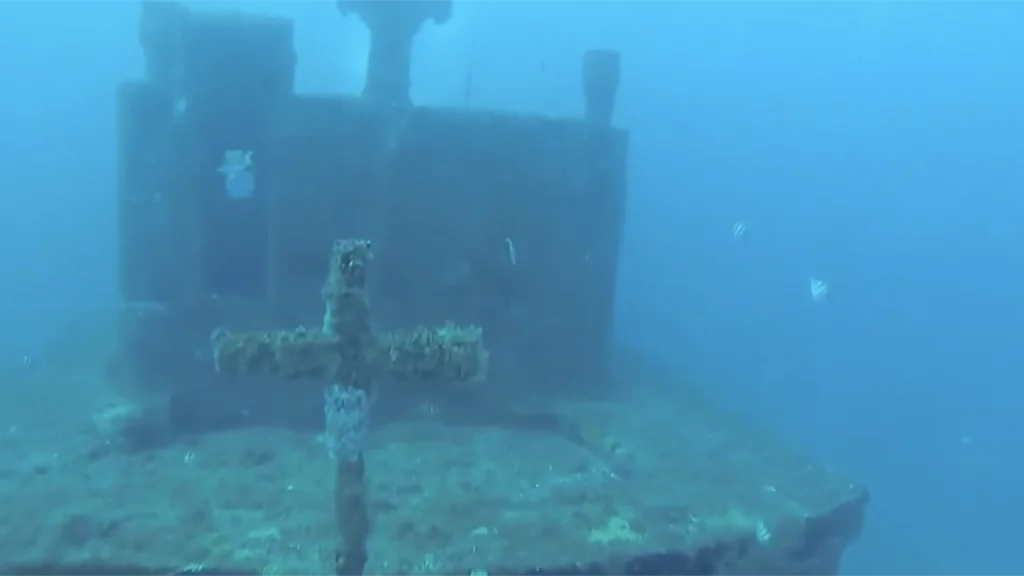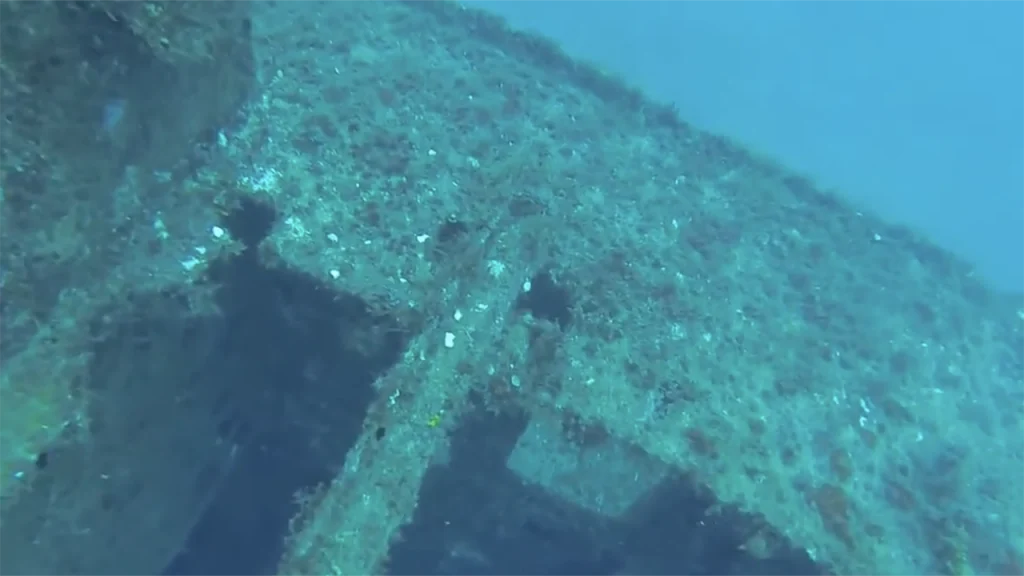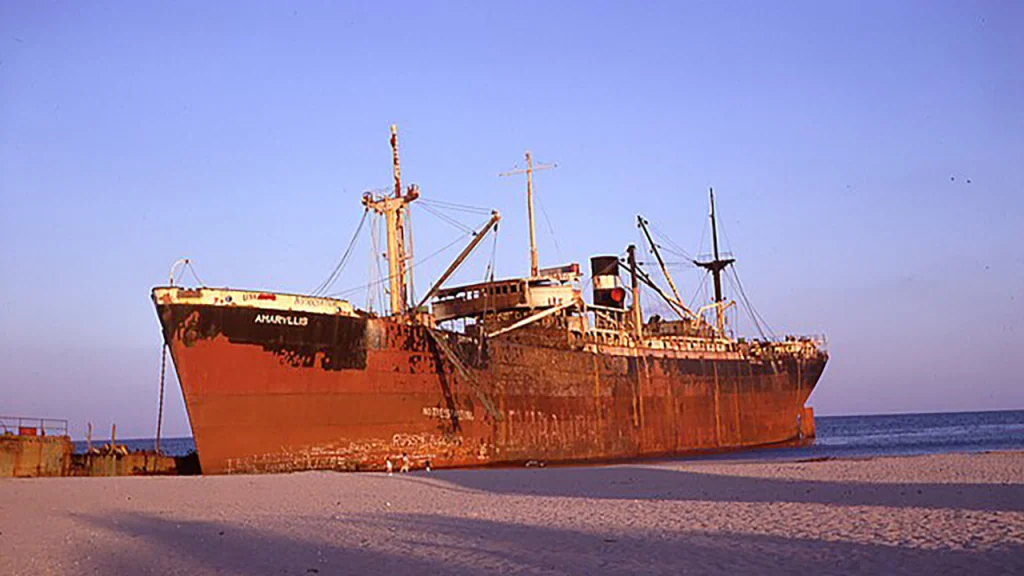Table of Contents

The Amaryllis offers a blend of size, history, and diving challenge within a multi-wreck system, making it a distinctive and popular dive site in the region.
Article at a Glance
- Historical Significance: The Amaryllis, originally built in 1945, ran aground during Hurricane Betsy in 1965 and was intentionally sunk in 1968 to create an artificial reef, making it a site of both historical and ecological interest.
- Unique Structure: Measuring 441.6 feet long, the wreck resembles a “canoe” shape on the seafloor due to extensive scrapping, providing divers with a distinctive underwater landscape to explore.
- Diving Conditions: Located at a depth of 80 feet (24 meters) near the Palm Beach Inlet, the Amaryllis is classified as an advanced dive site, requiring careful planning due to potential strong currents and visibility issues.
- Marine Life: The wreck serves as an artificial reef, attracting a diverse array of marine life, including Goliath groupers, barracudas, and various reef fish, enhancing the diving experience.
- Safety Measures: Divers are encouraged to have local knowledge, use proper equipment, and adhere to advanced diving protocols, including air management and buddy systems, to ensure safety while exploring the wreck.
- Dive Shops: Several local dive shops, including Blue Heron Bridge Scuba, Pura Vida Divers, and Force-E Scuba Centers, offer diving trips to the Amaryllis and other nearby dive sites.
- Cultural Impact: The Amaryllis has been featured in local culture, including its use as a backdrop for the daytime game show “Treasure Isle,” further cementing its place in the maritime history of Florida.
Shipwreck Location Coordinates and Depth
Depth
The wreck sits at a depth of 80 feet (approximately 24 meters).
Location Coordinates
The Amaryllis shipwreck is located at the following coordinates:
- Latitude: 26° 47′ 18″ N
- Longitude: 80° 0′ 58″ W

What Do Scuba Divers Say About This Ship
- It’s part of a highly regarded dive site: The Amaryllis is one of the main attractions in “The Corridor,” which is described as “definitely one of the best dives in Palm Beach County”.
- Impressive size: The Amaryllis is a large wreck, with its remains stretching about 400 feet long on the seafloor, resembling a giant canoe shape.
- Part of a multi-wreck dive: Divers can potentially visit multiple wrecks in one dive, as the Amaryllis is lined up with other wrecks like the Mizpah and PC1174, forming a 1700-foot drift dive.
- Marine life: While not specifically mentioned for the Amaryllis, the area is known for attracting various marine life. Divers report seeing Goliath groupers, sharks, barracudas, and sea turtles on nearby wrecks in the same area.
- Advanced dive site: The Amaryllis is classified as an “advanced dive site,” suggesting it offers an exciting challenge for experienced divers.
- Historical interest: The wreck has an interesting history, having been beached for nearly three years before being sunk as an artificial reef, which adds to its appeal for history-minded divers.
- Diving conditions: Divers note that it’s best to dive the Amaryllis during flood tide, as an outgoing tide can bring murky water from the nearby Palm Beach Inlet.
What Kind of Marine Life Can Be Found on The Ship
Common Marine Life
- Fish Species: The wreck likely attracts various reef fish common to Florida waters. This may include snappers, groupers, and tropical reef fish.
- Goliath Groupers: These large fish are known to frequent shipwrecks in the area, especially during spawning season in August and September.
- Baitfish: Schools of small baitfish, such as scad, may be present around the wreck, attracting larger predators.
- Predatory Fish: Species like jacks and barracudas are likely to be found hunting around the wreck.
Invertebrates and Corals
- Orange Cup Corals: These are mentioned as being profuse on nearby wrecks and are likely present on the Amaryllis as well.
- Sponges: Various species of sponges are likely to have colonized the wreck’s structure.
- Other Invertebrates: Crustaceans, mollusks, and other invertebrates typical of artificial reefs in the area are probably present.
Seasonal Visitors
- During certain times of the year, you might encounter sea turtles or larger pelagic species passing through the area.
Ecosystem Development
Given that the Amaryllis has been underwater since 1968, it has had over five decades to develop into a thriving artificial reef ecosystem. The wreck’s large size (400 feet long) provides ample surface area for marine life to colonize and inhabit.
Key Information
| Aspect | Information |
|---|---|
| Name of Ship | Amaryllis |
| Former Name | Cromwell Park |
| Year of Construction | 1945, constructed by Burrard Dry Dock Company in Vancouver, Canada |
| Wreck Specifications | Length: 441.6 feet (134.6 m), Beam: 57.2 feet (17.43 m) |
| Significant Event | Grounded during Hurricane Betsy on September 7, 1965; intentionally sunk in 1968 to form an artificial reef |
| Geographical Coordinates | Latitude: 26° 47′ 18″ N, Longitude: 80° 0′ 58″ W |
| Current Depth | Approximately 80 feet (24 meters) |
| Diving Level | Classified as an advanced dive site |
| Common Marine Species | Home to Goliath groupers, barracudas, and various reef fish |
| Diving Safety Protocols | Emphasis on local knowledge, appropriate gear, air management, buddy diving, and thorough pre-dive briefings |
| Local Dive Shops | 1. Blue Heron Bridge Scuba 2. Pura Vida Divers 3. Narcosis Dive Company 4. Force-E Scuba Centers 5. Salty Divers |
| Cultural Significance | Featured in the daytime game show “Treasure Isle,” enhancing its local maritime lore |
What Makes The Amaryllis a Unique Diving Experience
Historical Significance
The Amaryllis has an intriguing history, having run aground during Hurricane Betsy in 1965 and remaining beached for nearly three years before being intentionally sunk as an artificial reef in 1968. This backstory adds a layer of historical interest for divers exploring the wreck.
Part of “The Corridor”
The Amaryllis is a key component of “The Corridor,” an artificial reef system that includes multiple wrecks and structures. This allows divers to potentially explore several wrecks in a single dive, creating a more diverse and engaging experience.
Unique Shape
Due to extensive scrapping before sinking, the Amaryllis now resembles a 400-foot long “canoe” on the seafloor. This distinctive shape sets it apart from many other shipwrecks and provides an interesting underwater landscape for divers to explore.
Advanced Dive Site
Classified as an “advanced dive site,” the Amaryllis offers a challenging and rewarding experience for more experienced divers. The depth and potential currents contribute to this classification.
Marine Life
While specific marine life isn’t detailed for the Amaryllis itself, the area is known to attract various species. Nearby wrecks in “The Corridor” are frequented by Goliath groupers, sharks, and sea turtles, suggesting similar marine life may be found around the Amaryllis.
Diving Conditions
The wreck’s proximity to the Palm Beach Inlet creates unique diving conditions. It’s best dived during flood tide to avoid murky water pulled from the inlet during outgoing tides. This tidal influence adds an extra element of planning and timing to the dive experience.
How Does The Amaryllis Compare to Other Shipwrecks in Florida
Size and Shape
The Amaryllis is notably large, measuring 441.6 feet (134.6 m) in length. After extensive scrapping, it now resembles a 400-foot long “canoe” shape on the seafloor.This unique profile sets it apart from many other wrecks and provides divers with an interesting underwater landscape to explore.
Historical Significance
Unlike some intentionally sunk vessels, the Amaryllis has a compelling history. It ran aground during Hurricane Betsy in 1965 and remained beached for nearly three years before being sunk as an artificial reef in 1968. This backstory adds historical interest for divers.
Part of a Larger System
The Amaryllis is a key component of “The Corridor,” an artificial reef system that includes multiple wrecks. This allows divers to potentially explore several wrecks in a single dive, which is not common for many other Florida shipwrecks.
Diving Conditions
Its location near the Palm Beach Inlet creates unique diving conditions, with tidal influences affecting visibility. This adds an element of challenge and required planning that may not be present at other sites.
Marine Life
While specific marine life isn’t detailed for the Amaryllis, artificial reefs in Florida generally attract diverse sea life. The wreck’s long presence underwater (since 1968) has likely allowed for significant colonization by marine organisms.
Accessibility
Located at a depth of 80 feet (24 meters), the Amaryllis is accessible to advanced recreational divers, unlike some deeper wrecks that require technical diving skills.
What is The Full History of This Ship
Origins and Early Years
- Built in 1945 by Burrard Dry Dock Company in Vancouver, Canada.
- Originally named Cromwell Park.
- Length: 441.6 feet (134.6 m)
- Beam: 57.2 feet (17.43 m)
- Gross tonnage: 7,147 GRT
- Initially built for the Canadian government for use in World War II.
Ownership Changes
- In 1946, sold to Canadian Transportation Co. Ltd. and renamed Harmac Vancouver.
- In 1948, sold to Greek shipowner Kydoniefs, renamed Amaryllis, and registered in Panama.
The Grounding Incident
- On September 7, 1965, while en route from Manchester, England to Baton Rouge, Louisiana, the Amaryllis encountered Hurricane Betsy off the Florida coast.
- Seeking refuge in the Port of Palm Beach, the ship suffered steering problems.
- On the night of September 7-8, it ran aground on Singer Island beach in Riviera Beach, Florida.
- The Greek crew of 30 remained on board initially, attracting local attention.
Aftermath of Grounding
- Several unsuccessful salvage attempts were made by the original owners and a Miami buyer.
- The ship was eventually abandoned on the beach.
- It became a local attraction but also a hazard and environmental concern.
- One fire broke out on the ship during this period.
- The Army Corps of Engineers became involved in dismantling the ship and removing oil.
Final Fate
- On August 22, 1968, nearly three years after grounding, the remains of the Amaryllis were towed three-quarters of a mile offshore.
- It was intentionally sunk in 85 feet (26 m) of water to create an artificial reef.
Current Status
- Only the ship’s hull and lower deck remain at the artificial reef site.
- It’s now part of “The Corridor,” a string of wrecks and artificial reefs off Palm Beach.
- The wreck sits at a depth of 80 feet (24 meters) and is classified as an advanced dive site.
- Its unique “canoe” shape on the seafloor is due to extensive scrapping before sinking.
Cultural Impact
- The beached Amaryllis was used as a backdrop in the 1967-1968 daytime game show Treasure Isle.

What Historical Features Can Still Be Identified on The Amaryllis Wreck
- Hull Structure: The most prominent feature is the ship’s hull. After extensive scrapping prior to sinking, the Amaryllis now resembles a 400-foot long “canoe” shape on the seafloor. This distinctive profile is a key identifying characteristic.
- Lower Decks: The search results indicate that “Only the ship’s hull and lower deck remain at the artificial reef site”. This suggests that divers can still explore some of the ship’s lower deck structures.
- Overall Size: The Amaryllis was a large vessel, measuring 441.6 feet (134.6 m) in length with a beam of 57.2 feet (17.43 m). While altered, the sheer size of the remaining structure is a testament to its original dimensions.
- Orientation: The wreck lies with “her bow pointing southward”, which can help divers orient themselves and understand the ship’s layout.
- Lack of Superstructure: The absence of the ship’s superstructure is itself a historical feature, as it was removed during the salvage process. This gives the wreck its unique appearance and speaks to its history of being stranded on the beach for years before sinking.
- Potential Cargo Hold Remnants: Given that the Amaryllis was a cargo ship, there may be remnants of cargo holds visible in the remaining hull structure.
What Safety Measures Are in Place for Divers Visiting the Amaryllis Wreck
- Advanced Dive Classification: The Amaryllis is classified as an “advanced dive site,” indicating that only experienced divers should attempt to explore it.
- Local Knowledge Requirement: The site requires “local knowledge,” suggesting that divers should seek guidance from local dive operators or experienced divers familiar with the wreck.
- Proper Equipment: Divers likely need to carry appropriate wreck diving gear, including:
- Air Management: Divers must carefully plan their air consumption, potentially using enriched air (nitrox) to extend bottom time safely.
- Buddy System: Staying close to dive buddies and maintaining regular communication is crucial for safety.
- Penetration Limitations: If penetration is allowed, there are likely restrictions on how far divers can enter the wreck based on their training and experience.
- Pre-dive Briefings: Dive operators typically provide detailed briefings on wreck-specific hazards, entry/exit points, and emergency procedures.
- Dive Planning: Thorough dive planning, including determining turnaround points and safety stop locations, is essential.
- Environmental Considerations: Divers should be prepared for potential strong currents and limited visibility conditions that may occur at the site.
- Emergency Procedures: Established emergency protocols, including the use of alternate air sources and evacuation procedures, should be in place.
Dive Shops That Provide Diving Trips to This Shipwreck
- Blue Heron Bridge Scuba
- Address: 900 Blue Heron Blvd, Riviera Beach, FL 33404
- Phone: (561) 839-5130
- Open daily: 9 AM–6 PM
- Pura Vida Divers
- Address: 2513 Beach Ct, Riviera Beach, FL 33404
- Phone: (561) 840-8750
- Website: http://www.puravidadivers.com/
- Narcosis Dive Company
- Address: 200 E 13th St, West Palm Beach, FL 33404
- Phone: (561) 630-0606
- Website: https://narcosisdive.com/
- Force-E Scuba Centers – Riviera Beach (Blue Heron Bridge)
- Address: 155 Blue Heron Blvd, Riviera Beach, FL 33404
- Phone: (561) 845-2333
- Website: https://www.force-e.com/dive-shops/riviera-beach/
- Salty Divers
- Address: 800 US-1, Jupiter, FL 33477
- Phone: (561) 247-1119
- Website: http://saltydivers.com/





